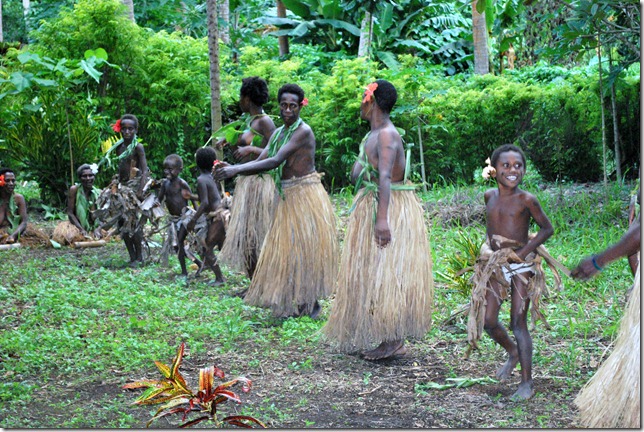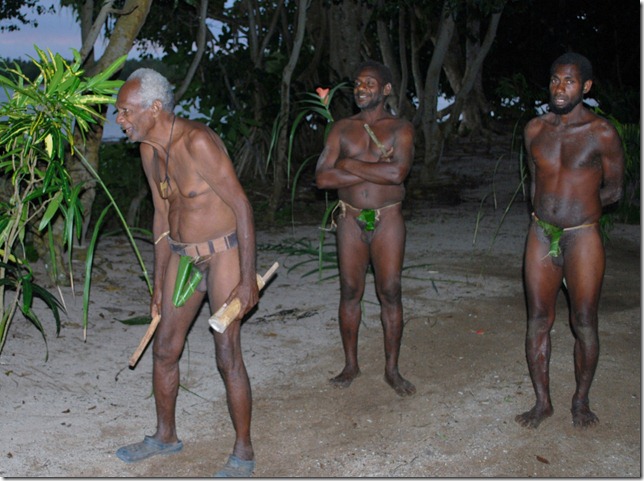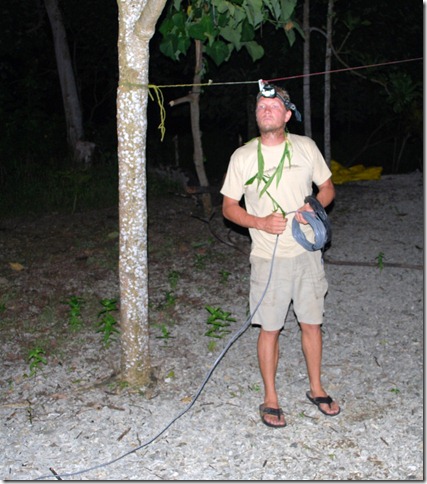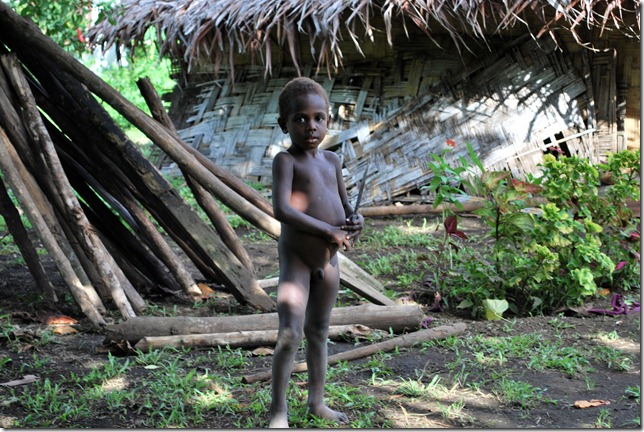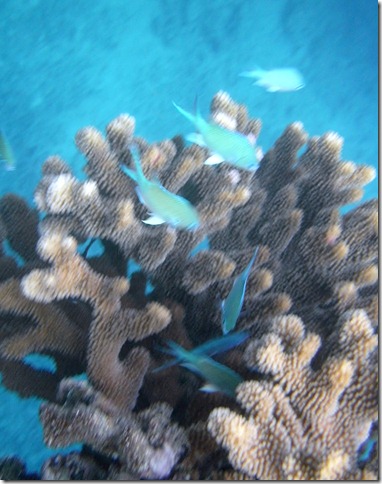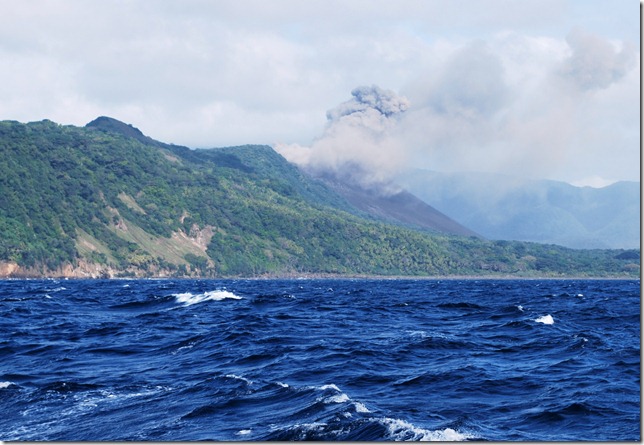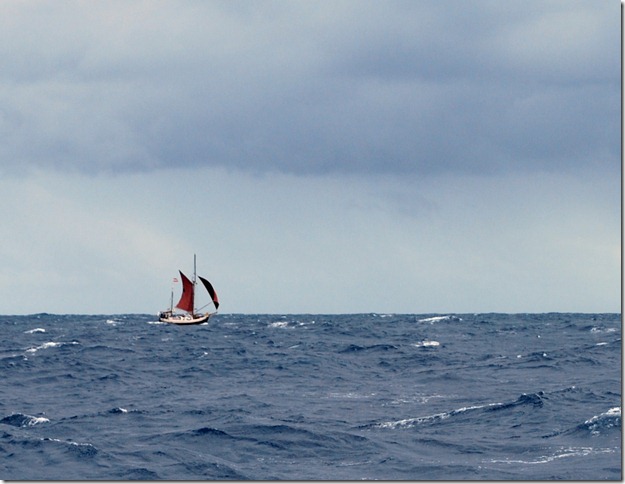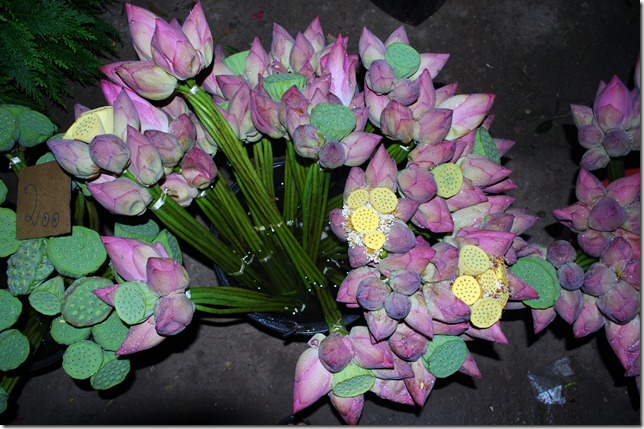I haven’t really felt well since Fiji, and yesterday I finally went to the doctor to try to get some answers. I’d had several symptoms, but the biggest was malaise and fatigue. Just something as simple as walking a couple of miles, which used to be fun, could be enough to leave me exhausted and give me a good fever until I ate and slept. Lately I’d started getting strange and unpleasant feelings in my stomach as well, and a 10-14 day passage to Australia was no time to have some sort of stomach emergency, so up the hill I went in a local taxi to the Luganville hospital.
The hospital wasn’t quite as desperate and dirty as the one in Tonga, although it was simple. It was a single story with no air conditioning, so the windows were open and the buildings were relatively small with open-air passages and space between them to allow the air to flow through. At reception I just had to provide my name and the $30 US expat consultation fee (about 3.5 times the rate for locals) then take a number and sit on one of the wooden benches in the covered, open-air waiting area. I was second in line, so I got to get up and see the Chinese doctor relatively quickly. I explained things and she had me lay on the table and then pushed down in various places around my abdomen. Apparently it’s only in the US that doctors learn to say things like "Hmmm", "Uh-huuh", and "Okaaay" as they examine you. It always makes me think they’re actually figuring something out as they go, but apparently in Chinese medical school, they don’t learn to ask you to tell them if it hurts, they just start pushing and trust that you’ll let them know if they found anything.
She found a spot to the right of my belly button that hurt and then it was back to the desk and she started filling out a couple papers. She thought malaria was a possibility, so one paper was for a malaria test. I asked her what all the pushing and probing meant and she said that appendicitis was out but that the spot where I was sensitive usually meant worms and than the second piece of paper was for an ultrasound to see what was going on in there. I asked how much the ultrasound would cost, and she laughed. It was covered in the $30 she said and I’d get my money’s worth.
I walked off to the Laboratory door, which was around the corner from the Blood Donor Bleeding room where a gray-haired local in flip-flops, camo shorts, T-shirt, and a white lab coat pricked my finger put the blood on a slide, and told me to come back in 15 minutes for the result of my malaria test. The ultrasound room was in the radiation section, but the ultrasound technician was on leave for a week, so the hospital in the second largest city in Vanuatu was without ultrasound until next week. I stopped by to see the doctor and let her know thinking there must be a work-around, but when I told her, she just had a look on her face like "Uh-oh, what should I do now?" followed by a look of resignation and told me to just get the results of the malaria test.
I waited outside the Laboratory door until the guy stuck his head out and handed me a piece of paper. The result was negative, so it was back to the doctor. She looked a little uncomfortable at having to make a decision without enough information, but as we were leaving the next day, she decided to give me medication to kill parasitic worms. We talked over symptoms again and she decided there were several different parasites it could be. She wrote down a couple of the names and started laughing a nervous, "I’m grossed out" kind of laugh when she told me about the one they called the black devil. "Ugh, black and ugly, eyes, little devil" she said as she drew a little face on the paper on her desk and then added horns and eyes as though it was a clinical depiction. Wow, I thought, that does seem like a plausible explanation for the way my stomach has been feeling the last few days. Since it takes a stool test to identify some of them (neither of us seemed to keen on that), she gave me one prescription for pills to kill the black devil, one for pills to kill various and sundry parasitic worms, and one for severe abdominal pain killers — "Very strong," she said, which worried me more than finding out I was likely host for the black devil worm.
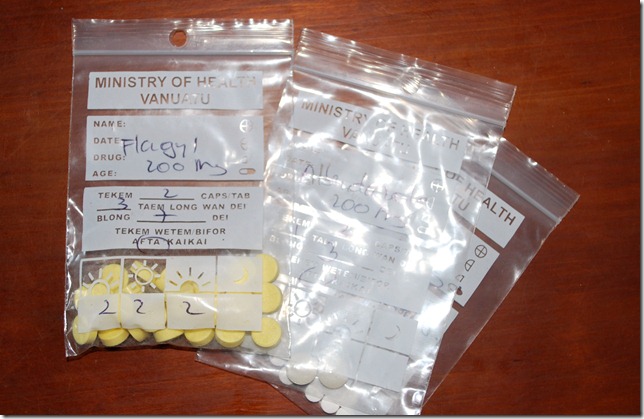
Check out the Bislamic instructions
All the medication was included in the cost of the consultation. The black devil pills were 2 a day 3 times a day for 7 days, so I started them after dinner that night. All night long my stomach gurgled and bubbled and in the morning the painful spot had moved from the right side of my stomach to the left, so I was optimistic that I might be on the way to recovery. My energy does seem to be coming back, and the condition of my stomach improving daily, so it seems like her guess was right. I hope so.
Jake told us to be at the yacht club at 3pm, but when he didn’t show up, we followed the trail to the village. He was waiting for us at the end of the trail and said we should come into the village to look over some things for sale by the women. Only one woman showed up with a few shells, necklaces, and a pamplemousse. We lounged around one of the afternoon houses, basically a floor with a roof and no walls that lets you enjoy the breeze and shade in the warmth of the day. Jake explained that we were on island time and the dance would occur eventually, but not in the immediate future. We took the time to relax, play with the village kids, and chat. Just at the preparations were nearing completion, a French boat anchored in the bay and I jogged back to the dinghy to invite them to the dance. Even though they’d just set the anchor and we’d never met, they jumped into the dinghy and joined us ashore.
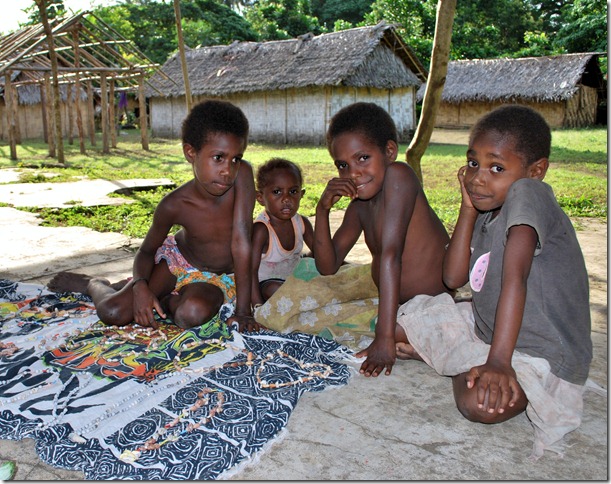 Hanging out with the village kids before the dance performance
Hanging out with the village kids before the dance performance
Preparations were complete and Jake was trying to gather us all up when we arrived back in the village. Things got underway with an official welcome to Banam Bay. Six girls and women, in order of increasing age, stood in a line to welcome us. They were bare-breasted with grass skirts, flowers in their hair, and a necklace made of leaves. We lined up as well and shook hands with each one, saying hello. The last one placed a necklace of leaves over our heads and we entered the women’s dance area, which was a sort of clearing with trees surrounding most of it. We walked through two lines of women dressed in the same way as the welcoming party and facing each other. When we reached the other side, Jake explained that the men and women would dance separately. The women would dance two dances – the first celebrating childbirth and the second celebrating marriage and becoming a woman. There were no taboos in this area and we were free to take pictures and the women among us were welcome to join in the second dance.
Four women were seated across from us, at the other end of the two lines, and after Jake’s introduction they began to sing and beat the hollow wooden percussion instrument that’s common throughout the Pacific. The youngest dancers were girls who were 10 or so and the oldest were starting to gray. The dancing was mostly stomping the heels in time with the percussion, although the second song involved the two lines repeatedly swapping places by walking past each other in the area between the lines. Lauren joined in on the second dance, and although she’s often the most enthusiastic person on the dance floor, a woman at the far end of the lines took the prize for turning the very understated dance into a much more lively affair involving swinging arms, legs, and other appendages. At the end of the second dance, we walked each line of dancers, shaking hands with each of them and thanking them for their performance.
It was then on to the men’s dancing. The men’s dancing was put on in a taboo area near the beach that women are not allowed to enter, with an exception being made for the female tourists. There were a couple of small huts, a sort of sculpture in the shape of a large, decorative head-like percussion instrument and two rows of green shoots that had been pushed into the sand to frame the dancing area, with us at one end and the sculpture at the other end. Near the sculpture stood the chief and several middle-aged men wearing only the namba and holding the wooden percussion instrument in their left hand and a stick to strike it with in their right hand. In case it’s not clear in the pictures, the namba is basically a large leaf that’s wrapped around the penis several times and then folded under a piece of bark that’s tied around the waist like a belt. The chief looked anything but frail and 98 with his wooden drum and namba. It was clear he was excited to be leading the dancing. Jake explained that there would be three dances – a warrior dance, a pig-killing dance, and a dance that celebrates circumcision and manhood. About 15 young men and boys then filed out of one of the huts, each wearing a namba and a black feather in his hair. The first two dances were done in moving lines with the heels keeping time with the percussion and music that was lead by the chief and the other men in the rear. As in other places, the men’s dancing was much more animated with yelling and throwing their hands over their heads. The third dance was done in a circle with the chief and older men in the center and the younger men around them celebrating with yells and legs kicking back behind them. Jake seemed not to notice than he was singing along and kicking his feet as well. It was a pretty rousing performance that was met with a healthy round of applause after each dance. After the dancing, the chief thanked us for coming and asked us each to introduce ourselves with our name, our home country, what we did for work, and anything else we wanted to add. After each person finished, the chief would beat the wooden drum and say thank-you.
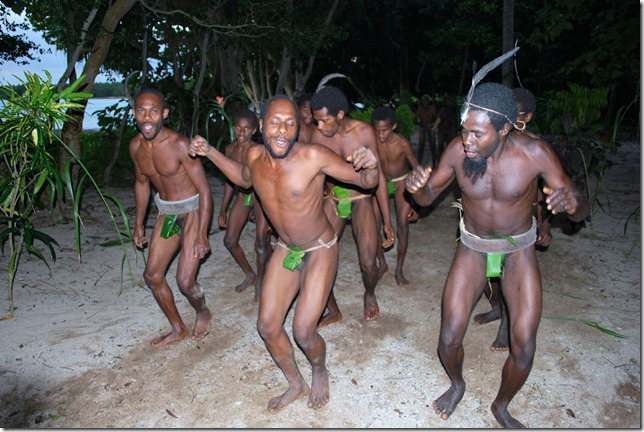 Not at all bashful in their nambas
Not at all bashful in their nambas
Next it was on to the food. They had cooked us a meal in the traditional way. Earlier in the day a fire had been lit to heat up stones, then the stones were placed in the ground with the food wrapped in banana leaves to make an underground oven. In the center was a dish of chicken and greens in coconut milk and around it was pieces of cooked tapioca. We sat in a circle around it, eating with our hands and then washing them in a bowl of seawater when we were finished. We then presented a few small gifts we’d brought for the village and paid for the dancing and food. Martin had brought a bag of medical supplies, a jerry jug, a hurricane lamp, and some kerosene and we’d brought some school supplies.
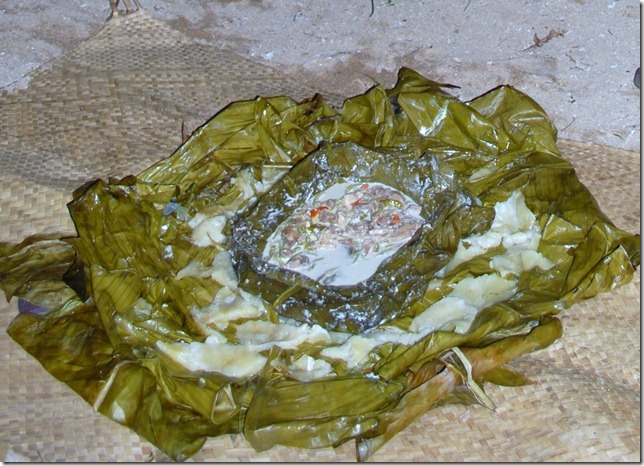 Leftover “lap-lap” that the dancers soon devoured
Leftover “lap-lap” that the dancers soon devoured
Night was falling as we made our way to Jake’s house. Several houses along the way were light with a single flashlight, a kerosene lamp, or a small fire. The village was quiet, but not yet sleeping. Back at Jake’s place I was able to run the wire from the battery hut to the living hut and install the two LED lights which he hung outdoors so we could see to have a round of kava. He made a short heartfelt speech that I’ll remember for a long time. He said that kava was a special way to greet guests and he was glad to share with all of us (the ladies got to partake as well). He said that he’d had a solar panel for 3 years but never had light in his home and that he would always remember us for bringing a second life to his home. He downed the first cup of what was definitely the strongest kava we’ve tasted and we chatted for 15 minutes or so before making our way through the dark village and woods back to the dinghies resting on the beach.
We said goodbye to the French couple, who we’d just met and to Martin. Martin has been our best friend and a great companion for nearly a year now and from here our paths diverge. He’ll stay longer in Vanuatu and then make his way through Asia and the Red Sea back to Europe next spring. We’re planning to take the South Africa route across the Indian Ocean and, if all goes according to plan, will be nearing the US about the time he’s in Greece. We’ll probably miss each other in Darwin and Bali by a week or two. The next time we meet it will likely be as tourists on land in Europe or the US instead of as sailors at sea or in a small island anchorage.
We left Lamen Bay with Anima at about 6am and sailed for the nearby island of Malakula. Malakula is one of the larger islands in Vanuatu, but isn’t too heavily populated and doesn’t have a large, modern city. In the past, the residents of the island were grouped in the large nambas and small nambas, according to the size of the namba they wore, with the large nambas living in the northern part of the island and the small nambas living in the south. The namba is the traditional male garment on Malakula. You probably haven’t seen one at the Gap, unless they’ve added a “penis sheath made from a large leaf” section since we’ve left.
We raced Anima to Banam Bay (we won, so it was an official race) and caught a yellow-fin tuna on the way that was gone within minutes of dropping the anchor in the large, tranquil bay. The cruising guide said to take the dinghy in toward a large tree in the middle of the white sandy beach, which must have been a joke as the boat was surrounded on two sides by a long, white, sandy beach more than a mile long with no particularly noteworthy trees. The guide also said that a nice traditional dance could be arranged with the chief for $15 each, and it was already afternoon so we hurried in to the beach near some out-of-place looking buoys.
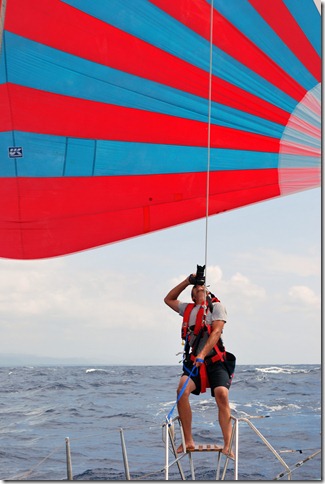 Colin got some interesting shots on the passage to Banam Bay
Colin got some interesting shots on the passage to Banam Bay
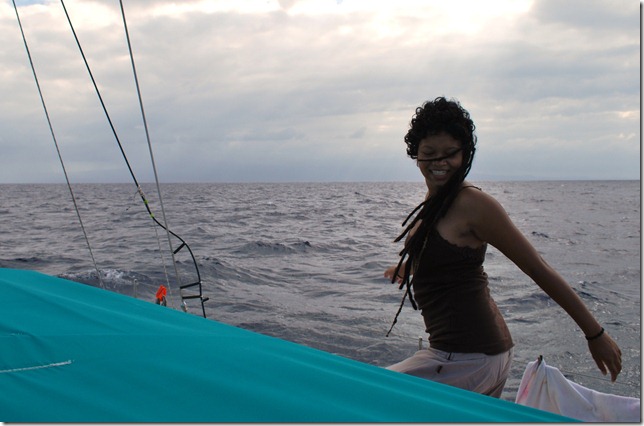 Shiroma’s music inspired the girls to dance
Shiroma’s music inspired the girls to dance
We were met at the beach by Jake, who spoke pretty good English and showed us the “yacht club” they had started building several years earlier. It was a nice little structure with a conical roof, a couple of benches and a bar/kitchen area, but it had never been utilized. Jake was in charge of the “yacht club” and was the apparent Banam Bay ambassador to yachties. He assured Martin that he could watch the night’s World Cup games at a school about an hour’s walk away and then took us to meet the chief to arrange for the dancing. He had us stop at the edge of the village and wait for Chief Saro. Nearly everyone was living in thatched-roof huts with woven bamboo walls and they were pretty curious to see us, especially the children. Jake later told us we were the first yachts of the year to stop in Banam Bay. Jake told us the chief was 98 years old, and as he swayed out of his hut and his steps meandered weakly back and forth on his walk toward us, I was afraid that we might be the last yachties he saw. He must have been napping, because he seemed to get stronger as he walked toward us and by the time he reached us he was chiefly presence. He shook hands with all of us, welcomed us to his village and Banam Bay, and we introduced ourselves and told him we were interested in the custom dancing. He then exchanged a few words with Jake who told us that the dance would be at 3:30 the next day followed by a lap-lap (food for us involving chicken and coconut).
We all said goodbye to the chief and then Jake led us down the road through the village. The children were absolutely taken with Lauren and her camera and she and Shiroma spent much of the time surrounded. Shiroma’s long dreadlocks were fascinating to them as well, and she said at one point a different child was holding onto each dreadlock. Jake and I had a nice talk while we walked. He’s been working with an American medical project to bring occasional medical care to the villages. The village seemed fairly primitive and without electricity. Nobody in the village owned a truck, although Jake said trucks and the track through the forest had first appeared about 25 years ago. Cell phone coverage had just arrived in the village last year and there were already two competing providers. Being a relatively young democracy with little in the way of mass communications to the more remote areas, politicians and political workers travel through the countryside the month before the elections telling people about the candidates and then the villagers go to the local school to vote. Although Bislama is the national language and the only one that allows all ni-Vanuatu people to communicate, Jake and numerous others spoke pretty good English.
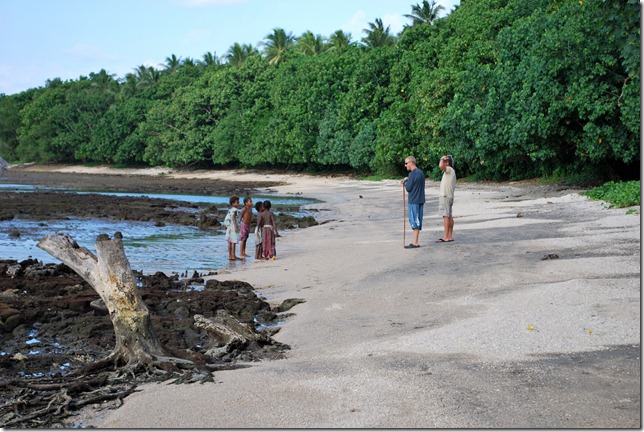 Checking out the tall white men from a distance
Checking out the tall white men from a distance
Near the end of the village we arrived at Jake’s house and met his wife Lucy, two young boys, and several friends. Jake has three huts – one for living in, one for cooking, and a third that perhaps is an older house but is now mostly empty. He’d asked me what I did for work in the states and I’d told him that I’d done some electrical engineering. When we got to his house he showed me a solar panel, battery, regulator, and inverter that had never worked and wondered if I could do something to fix them. It was all novel technology to him, but he knew what they were capable of and really was anxious to have electricity. He’d had the solar panel for several years but never gotten it to do anything.
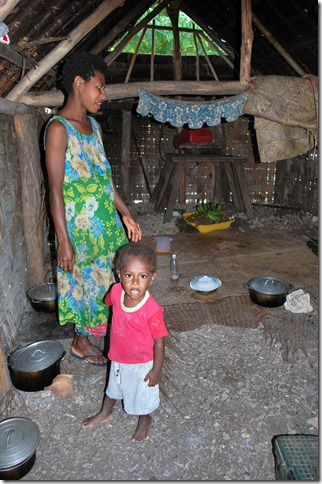 Lucy showing us her cooking hut
Lucy showing us her cooking hut
The next morning, after watching the World Cup all night, Martin dropped Jake off at our boat. We ate breakfast and I collected some tools and a spare engine starting battery that I’d been keeping for some reason even though it was too weak to turn the engines. Colin joined us we dinghied across the bay to Jake’s house, with Jake and I carrying the battery down the beach and into the dark hut. After a bit of troubleshooting, I was able to determine that the solar panel was in good condition and working fine and the regulator worked once a broken input wire was repaired and several bad connections were cleaned and renewed. His battery was toast after sitting unused for over year, but my old one worked just fine and after fiddling with connections we were able to power-up the American inverter that someone had left him. I’ll never forget the look of joy on his face when he plugged in his cell phone charger and the phone lit up with the charging symbol. It was a project that had apparently been years in the making. I explained a few basics about how to get the most from the solar panel and how to repair the wiring and left a cheap spare voltmeter. He said that he would like to have a light in his home at night, so I walked off the distance from the hut with the battery to his living house and told him that after the dancing I would come back and rig up some lighting. He was pretty pleased and said he’d arrange to have kava for us all in his home after the dance.
Colin and I sped back to the boat where I worked to string together 70 feet of wire from three different spare sections I had on board. I also took a 12V LED strip-light that I’d gotten as a gift from S/V Imagine and broke it into two separate lights, soldered on lead wires, and taped it into the original clear packaging to make two bright, power-efficient, and somewhat rain-proof lights. Then it was time for a short nap before the afternoon’s activities.
We got off to an early start, pulling the anchor from around the coral heads and sailing north along the west coast of Efate. Once we got out into open water north of Efate, the wind and seas really picked up and soon we were moving along at over 6 knots on just the jib with some decent-sized waves on the beam. We made it to Cook’s Reef with about an hour and a half of sunlight left, and just as we sailed past the southwest corner of the reef, we caught a barracuda. They’re good eating if they’re caught in open water, but can be poisoned with ciguatera if they’re near a reef, so we ultimately decided not to filet him.
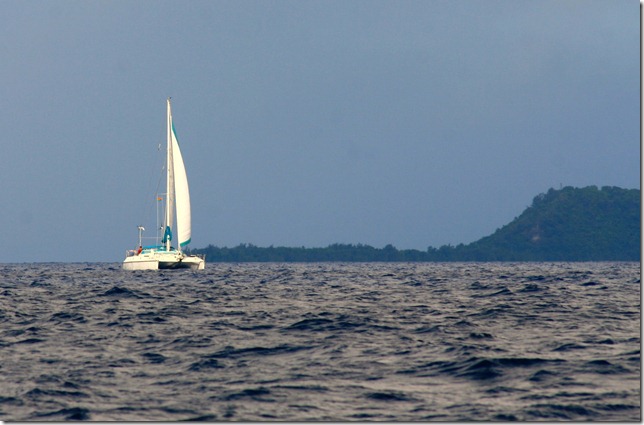 View from S/V Marionette as the racing boat careened past
View from S/V Marionette as the racing boat careened past
The reef is about a mile and a half across and out in the middle of open water. It’s not charted very well, but we’d read that the diving was great, so we really wanted to try and stop. After our reef encounter in Fiji we were extra careful, but still had a close call before we were eventually able to anchor on the west side of the reef where the seas were blocked. It was too late to dive, so swam in to the edge of the reef for a snorkel. The size of the whole thing was really amazing and there was no shortage of fish and coral. I’d taken the speargun, but missed a great shot on a large parrotfish and mostly saw large fish too deep and small fish in the shallow water. The sun was getting low in the sky, so we headed back toward the boat, and then I noticed that there was a large sloping wall of coral full of fish just 100 feet or so from the boat. We’d completely missed it. There was just enough light left for me to get down and spear a grouper hiding in the coral before swimming back to the boat.
Colin cleaned the grouper and we pulled anchor and moved off of the reef just as the sun was setting. Our original plan was to sail overnight to the island of Ambrym where there is another larger volcano, but the wind, which has been strong the whole time we’ve been here, wasn’t from a good direction so we headed for Lamen Bay on the island of Epi. Coming in at night is never fun, but the bay is reasonably open, we had some decent charts, and there were a couple of boats already there to anchor between. When we awoke, Anima was anchored beside us and Marionette showed up later in the day.
Lamen Bay is known for a friendly dugong (manatee) that swims there and lets people swim nearby it. We weren’t luck enough to see it while we were there, but we did have a nice walk around the village, enjoying a couple of drinking coconuts and stopping for a warm beer at the local “resort”. Along the way, Shiroma met a couple of guys (one from Argentina and one from Germany) that she’d met while backpacking in New Zealand. Needless to say, she was pretty surprised to find them walking along the path in the village. They’re travelling slow and cheap and enjoying the island life, which has been pretty hospitable to them. We had a few rain showers in the middle of some afternoon snorkeling and boat projects that added to the unbroken streak of days with rain that started when we arrived in Tanna.
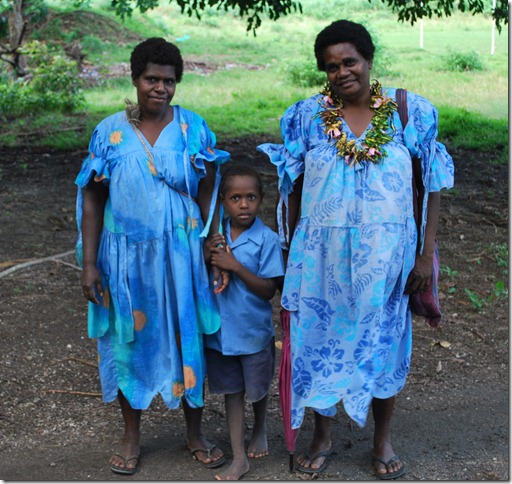 Some residents of the village on Epi Island
Some residents of the village on Epi Island
The day after we slowly made our way to the top of the awesome volcano on Tanna, we were all pretty exhausted, and Dallas and Shiroma were feverish, so we decided to stick around and do very little for a day before sailing on to Port Vila. Ash managed to have a few more interesting encounters that day with locals who were interested in trading for gasoline, money, etc. The locals had lots of bartering power since they knew where to get home-grown tobacco and coffee, both of which Ash was in desperate need of.
We got up early the next morning and weighed anchor just before Anima. Shiroma jumped on the VHF to start the trash-talking with Martin to get him in the mood for a race to Port Vila. I guess she did a good job as he weighed anchor very quickly with his manual windlass, and we were soon on the same course passing by the continually smoking volcano. Anima’s two smaller sails outmatched our one jib in the strong but inconsistent following winds, and he arrived a few hours ahead.
Port Vila is the largest city in Vanuatu, and from the harbor it looks quite nice. The water is as clear as any city harbor water that I’ve ever seen (much better than Suva!), and there is lush vegetation all around. However, the main drag of town is catered to cruise ship passengers, so there’s a duty free shop on every corner, a few restaurants, bars, and resorts, and not much in the way of culture besides the colorful market.
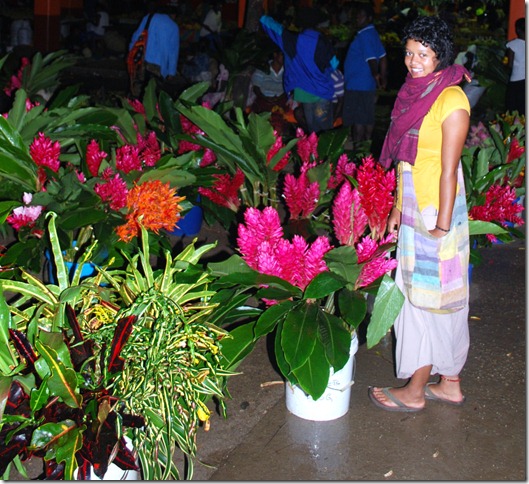 The tropical flowers are stunning
The tropical flowers are stunning
And sometimes surreal-looking
We ended up spending the weekend on a mooring just in front of the Waterfront Bar and Grill which turned out to be an especially convenient spot since it rained almost the whole time. Fortunately we had lots of people to socialize with. In particular I want to mention the German couple who are crewing on Anima because of their unique travel plans. They are just a bit older than us and after seven years of marriage, they took off on a "partner year" of travel that consists of destinations like here, the Great Wall of China, South Africa for the World Cup finals, Canada, etc. Their enthusiasm is contagious, and it’s worth taking a look at their pics even if you can’t understand German–"www.partnerjahr.de".
The nightlife in Vila consisted mostly of a couple of bars and dance clubs for tourists, but we briefly stopped in for a drink at one of the locals’ clubs on Saturday night. We got our fair share of attention since we were the only white people there, but I found the local men and women to be friendly and laid back. (Shiroma says the men were aggressive.) Almost everyone was dancing to the reggae music.
The Waterfront Bar turned out to be the place where cruisers congregated and waited out the rain, and it was there that we met the Kiwi delivery skipper for a 65′ superyacht called Anteus. Reese invited us over for some "nibbles" and to check out the boat on Sunday night, and we were all pretty impressed. It’s a racing yacht with a flat bottom and retractable keel that has been converted into a cruising yacht (sort of). With 400 square meters of sail, it planes across the surface of the water at speeds of up to 25 knots. It seemed to be an ideal boat for Reese who says has a new lease on life after a rugby accident that left him with a broken back and neck. His philosophy of "strong winds = hoist more sail" seems to be working out for him in the racing world as he just came 2nd in the solo Tasman race and is planning to participate in the Vendee Globe solo-round-the-world race next year.
Monday we checked out, provisioned with duty free supplies that can’t be opened until we leave Vanuatu (a big test of Ash’s will power!), and sailed out to Paul’s Rock just a few hours northwest of Vila. We arrived in time for some outstanding snorkeling before sunset. The fish here are fed by the local villagers on a regular basis, so they approach people when they get in the water! There were schools of fish of various kinds when we hopped in, and sure enough, when Colin swam past me, I could see a trail of fish swimming behind! The water was crystal clear, and the coral heads were blossoming with various shapes and colors.
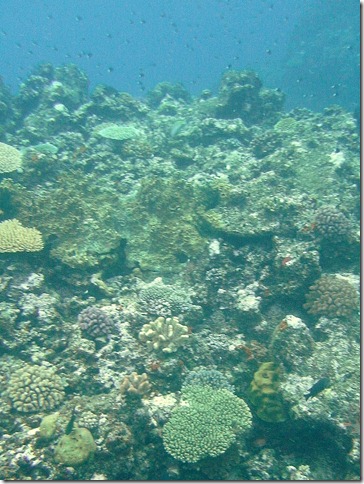 Plentiful coral at Paul’s Rock
Plentiful coral at Paul’s Rock
Shortly after we finished snorkelling, S/V Marionette arrived as planned, and we decided to finish the day with a fire on the beach. We headed to bed early after a weekend of late nights in the "city" (most of our crew got up at 1:00 a.m. the night before to watch Germany advance to the quarter finals of the World Cup) and slept extremely well with the rain pattering down on the boat.
Today we snorkeled some more and then dinghied over to a waterfall that Ash spotted from the boat, only to discover that we had landed our dinghy on the beach where Survivor: Vanuatu was filmed. We met a man from the nearby village who said he couldn’t take us to the waterfall without offering some money to the owner of the land (the chief of the neighboring village, I guess), but when he learned we just wanted to see the falls that we could see from the boat (just a little one caused by runoff from the rain), he agreed to take us in exchange for some tobacco. His English was really good, and he turned out to be an entertaining guide. We followed he and his dogs up through the mud to the landing where the water pooled and had a great time standing in the pool and letting the cool freshwater stream down over us. On the way back down the hill, Cathi and I spotted an interesting orange fruit growing in a tree. The guide used his knife to open it for us to reveal cocoa beans covered in a sweet white jellyish substance. Between this and the coconuts, crabs, fish, and wild pigs, the Survivor contestants were spoiled for choice of foods on this island!
Speaking of being spoiled, Shiroma is currently cooking another pizza, this time with garlic and a leafy green from the market that we are calling spinach. As much as I enjoyed French Polynesia, it was seriously lacking in reasonably priced quality food (esp. dairy products), and having them around definitely adds to the cruising experience. So does having Shiroma around!
Tomorrow the plan is to sail up to Cook’s Reef to do some scuba diving, followed by a night sail to Ambrym, called the "Black Island" due to the volcano ash and the use of black magic. There’s so much to see and do here in Vanuatu that we could easily spend a few months here, but we need to keep moving if we are going to make it to Indo by the end of August.


